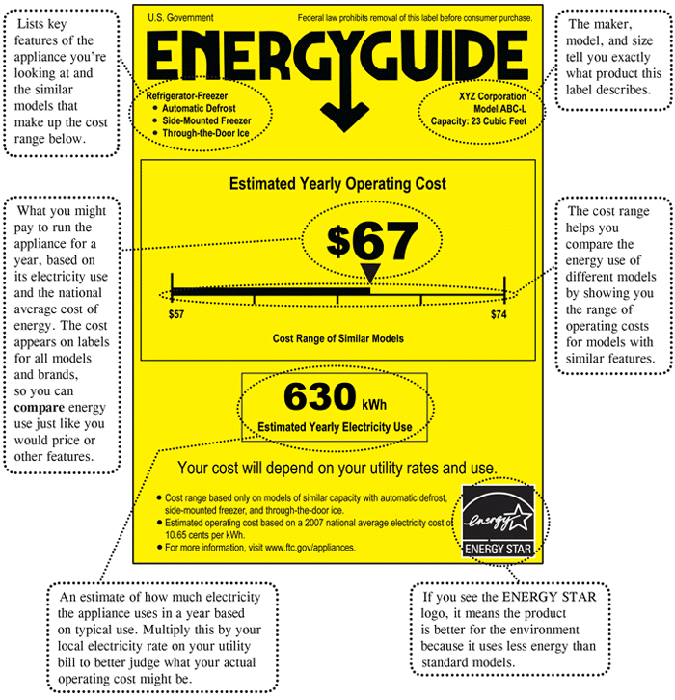- Energy Guidance: Appliance Shopping With the EnergyGuide Label
If you’ve shopped for appliances, you’ve seen the bright yellow EnergyGuide label. Recently revised so it’s easier to use, the label tells you how much energy an appliance uses. The EnergyGuide label can help you compare the energy use of different models as you shop for an appliance. The more energy efficient an appliance is, the less it costs to run, and the lower your utility bills. Using less energy is good for the environment, too; it can reduce air pollution and help conserve natural resources. sample below explains how to use the label.
How to Use the EnergyGuide Label
Appliances have EnergyGuide labels
- clothes washers,
- dishwashers,
- refrigerators,
- freezers,
- water heaters,
- window air conditioners,
- central air conditioners,
- furnaces, boilers,
- heat pumps,
- pool heaters.
Televisions, ranges, ovens, clothes dryers, humidifiers, and dehumidifiers don’t have EnergyGuide labels. The national average electricity cost are updated every five years. Appliance manufacturers use their estimated costs on the same electricity rate, so EnergyGuide labels won’t always reflect actual electricity prices. www.ftc.gov/appliances
EPA Announces New Energy Star Requirements for Dishwashers and Furnaces
WASHINGTON – July 19, 2011
The U.S. Environmental Protection Agency (EPA) is updating Energy Star requirements for home dishwashers and furnaces. The new requirements are a part of Energy Star’s overall commitment to protect people’s health and the environment by encouraging energy efficiency.
Effective January 20, 2012, both standard-sized and compact residential dishwashers meeting the new Energy Star requirements will be between 10 and 30 percent more energy efficient than conventional models, and about 8 percent more efficient than dishwashers that met the previous Energy Star requirement. If every dishwasher in the U.S. met the new requirements, consumer energy and water bill savings would grow to approximately $235 million per year, reducing annual greenhouse gas emissions equivalent to those from more than 180,000 vehicles.
Distributors, contractors and consumers will also be able to identify and purchase Energy Star qualified furnaces that are appropriate to their particular climate zone beginning February 1, 2012. The furnaces that meet the new requirements for the southern half of the U.S. will be labeled with a specific U.S. South Energy Star mark. The qualified furnaces in the South, where homes require less heat, will be up to 12 percent more energy efficient than baseline units. Qualified furnaces in the northern half of the U.S. including Canada will bear the standard Energy Star logo and will be up to 16 percent more energy efficient than baseline models. If every gas furnace sold in the U.S. were to meet the new Energy Star requirements, which are up to 5 percent more efficient than the previous Energy Star requirement, consumer energy bill savings would grow to more than $170 million per year and reducing annual greenhouse gas emissions equivalent of those from approximately 175,000 vehicles.
In order to earn the Energy Star label under the new requirements, product performance must be certified by an EPA-recognized third-party, based on testing in an EPA-recognized laboratory. In addition, manufacturers of the products must participate in verification testing programs run by recognized certification bodies. The new requirements for residential dishwashers and furnaces are among the 20 revisions to product requirements expected to be completed this year.
Energy Star was started by EPA in 1992 as a market-based partnership to reduce greenhouse gas emissions through energy efficiency. Today, the Energy Star label can be found on more than 60 different kinds of products, as well as new homes and commercial and industrial buildings that meet strict energy-efficient specifications set by the EPA. Last year alone, Americans, with the help of Energy Star, saved about $18 billion on their energy bills while preventing greenhouse gas emissions equivalent to the annual emissions from 33 million vehicles.
To earn the ENERGYSTAR, a product must meet strict energy efficiency guidelines set by the Environmental Protection Agency and Department of Energy, visit www.energystar.gov

